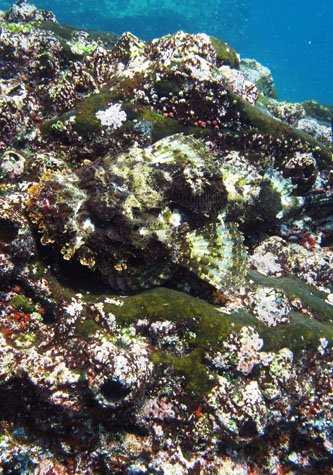We arrived to our anchorage off the western coastline of Santiago (also known as James or San Salvador) in the early hours of the morning in a full-blown “garua” day. Heavy mist could be seen covering the highlands of the island, and a frisky wind had us using windbreakers. The first Zodiac away from the ship pulled a string of kayaks; then repositioned to one side of the beach, against the lava peninsula, where we got into our chosen mode of transport. For the next hour we paddled along a rough shoreline of broken lava and fallen layers of tuffstone, and discovered Galápagos fur seals out and about. The coolness of the air and water temperature was ideal for them with their thick pelage. Their rough calls echoed against high cliffs. One section had a few saltbushes, and brown pelicans were nesting. One nest had three chicks—large and ungainly, but vigorous as they begged from the adult who had just arrived with food to regurgitate into their large beaks. I commented that the calls sounded prehistoric, dinosaur-like; but only because Hollywood chose that sound first!
Meanwhile on shore, the walkers had discovered several Galápagos hawks, mostly juveniles, hanging about this heavily used marine turtle nesting beach. Although early yet (and cool), several fresh tracks could easily be seen. Female east Pacific green sea turtles had obviously been up on the sand last night, either nesting already, or at least checking it out for the future, when the temperatures will be warmer and more conducive to incubating fragile reptile eggs.
After breakfast, the ship moved a couple miles north into Buccaneer Bay, and the blue sky took over. Snorkeling! Again! Sea lions checked us out, a stone scorpionfish was found and with difficulty shown to others. Parrotfish, moorish idols and surgeonfish, damselfish, grunts, wrasses, and even a horse conch appeared—its bright red mantle standing out in contrast to the dull rock surface.
Those who did not snorkel had a Zodiac trip around the base of these historic cliffs, a bay where all pirates, whalers, and other adventurers stopped for re-supply. Even the Beagle spent time here collecting giant tortoises and water, and dropping off Darwin for a nine-day stay.
Puerto Egas was our afternoon destination, where the afternoon light and low tide displayed a setting seemingly designed for photographers. Reflections off tide-pools, Sally Lightfoot crabs and oystercatcher bills in red, marine iguanas in russet and black, sea lions and fur seals in shades of brown. These natural tones were matched by the warm sunset colors that ended the day.
The grand finale for everyone who ended up on the beach at this hour was a fabulous feeding frenzy that involved blue-footed boobies and brown pelicans. The bombardment of javelin-shaped boobies into the sea surface was astounding. The spiraling bodies both entranced and mesmerized; the sound of dynamic bodies entering the water unique as no other; another one-of-kind day in Galápagos.







